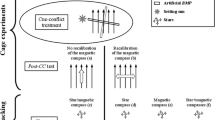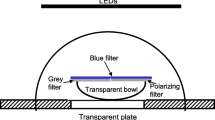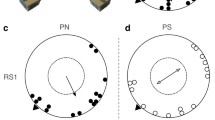Abstract
To assess the role of skylight polarization in the orientation system of a day-migrating bird, Yellow-faced Honeyeaters (Lichenostomus chrysops, Meliphagidae) were tested in funnel cages for their directional preferences. In control tests in the natural local geomagnetic field under the clear natural sky, they preferred their normal migratory course. Manipulations of the e-vector by depolarizing the skylight or rotating the axis of polarization failed to affect the orientation as long as the natural geomagnetic field was present. When deprived of magnetic information, the birds continued in their normal migratory direction as long as they had access to information from the natural sky, or when either the sun or polarized light was available. However, when sun was hidden by clouds, depolarizers caused disorientation. — These findings indicate that polarized skylight can be used for orientation when no other known cues are available. However in the hierarchy of cues of this species, the polarization pattern clearly ranks lower than information from the geomagnetic field.
Similar content being viewed by others
References
Able KP (1982) Skylight polarization patterns at dusk influence migratory orientation in birds. Nature 299: 550–551
Able KP (1989) Skylight polarization patterns and the orientation of migratory birds. J Exp Biol 141: 241–256
Able KP, Able MA (1990) Ontogeny of migratory orientation in the savannah sparrow, Passerculus sandwichensis: mechanisms at sunset. Anim Behav 39: 1189–1198
Able KP, Able MA (1993) Daytime calibration of magnetic orientation in a migratory bird requires a view of skylight polarization. Nature 364: 523–525
Able KP, Able MA (1994) The development of migratory orientation mechanisms. J Ornithol 135: 372
Able KP, Cherry JD (1986) Mechanisms of dusk orientation in white-throated sparrows (Zonotrichia albicollis): clock-shift experiments. J Comp Physiol A 159: 107–113
Batschelet E (1981) Circular statistics in biology. Academic Press, London
Bingman VP (1983) Importance of the earth's magnetism for the sunset orientation of migratory naive savannah sparrows. Monit Zool Ital 17: 395–400
Bingman VP, Wiltschko W (1988) Orientation of dunnocks (Prunella modularis) at sunset. Ethology 77: 1–9
Brines ML (1980) Dynamic patterns of skylight polarization as clock and compass. J Theor Biol 86: 507–512
Coemans MAJM, Vos JJ, Nuboer JFW (1990) No evidence for polarization sensitivity in the pigeon. Naturwissenschaften 77: 138–142
Delius J, Perchard R, Emmerton J (1976) Polarized light discrimination by pigeons and an electro-retinographic correlate. J Comp Physiol 90: 560–571
Emlen ST, Emlen JT (1966) A technique for recording migratory orientation of captive birds. Auk 83: 361–367
Frisch Kv (1949) Die Polarization des Himmelslichts als orientierender Faktor bei den Tänzen der Bienen. Experientia 5: 142–148
Frisch Kv (1968) The dance language and orientation of bees. Harvard University Press, Cambridge
Helbig AJ (1990) Depolarization of natural skylight disrupts orientation of an avian nocturnal migrant. Experientia 46: 755–758
Helbig AJ (1991) Dusk orientation of migratory European robins, Erithacus rubecula: the role of sun-related directional information. Anim Behav 41: 313–322
Helbig AJ, Wiltschko W (1989) The skylight polarization patterns at dusk affect the orientation behaviour of blackcaps, Sylvia atricapilla. Naturwissenschaften 76: 227–229
Kreithen ML, Keeton WT (1974) Detection of polarized light by the homing pigeon, Columba livia. J Comp Physiol 89: 83–92
Liddy J (1966) Autumnal migration of the yellow-faced honeyeater. Emu 66: 87–104
Martin GR (1991) The question of polarization. Nature 350: 194
Moore FR (1986) Sunrise, skylight polarization, and the early morning orientation of night-migrating warblers. Condor 88: 493–498
Moore FR, Phillips JB (1988) Sunset, skylight polarization and the migratory orientation of yellow-rumped warblers, Dendroica coronata. Anim Behav 36: 1770–1778
Munro U, Wiltschko W (1992) Orientation studies on yellow-faced honeyeaters, Lichenostomus chrysops (Meliphagidae), during autumn migration. Emu 92: 181–184
Munro U, Wiltschko R (1993a) Clock-shift experiments with migratory yellow-faced honeyeaters, Lichenostomus chrysops (Meliphagidae), an Australian day migrant. J Exp Biol 181: 233–244
Munro U, Wiltschko W (1993b) Magnetic compass orientation in the yellow-faced honeyeater, Lichenostomus chrysops, a day-migrating bird from Australia. Behav Ecol Sociobiol 3: 141–145
Petterson J, Sandberg R, Alerstam T (1991) Orientation of robins, Erithacus rubecula, in a vertical magnetic field. Anim Behav 41: 533–536
Phillips JB, Moore FR (1992) Calibration of the sun compass by sunset polarized light patterns in a migratory bird. Behav Ecol Sociobiol 31: 189–193
Robertson JS (1965) Migration of yellow-faced honeyeaters. Aust Bird Band 3: 33–34
Robertson JS, Woodall PF (1963) The status and movements of honeyeaters at Wellington Point, south-east Queensland. Sunbird 13: 1–14
Sandberg R (1988) Skylight polarization does not affect the migratory orientation of European robins. Condor 90: 264–270
Waterman TH (1981) Polarization sensitivity. In: Autrum H (ed) Handbook of sensory physiology, vol. VII/6B. Springer, Berlin Heidelberg New York pp 23–41
Wehner R (1982) Himmelsnavigation bei Insekten. Naturforschende Gesellschaft, Zürich
Wiltschko W, Wiltschko R (1975a) The interaction of stars and magnetic field in the orientation system of night migrating birds. I. Autumn experiments with European warblers (Gen. Sylvia). Z Tierpsychol 37: 337–355
Wiltschko W, Wiltschko R (1975b) The interaction of stars and magnetic field in the orientation system of night migrating birds. II. Spring experiments with European robins (Erithacus rubecula). Z Tierpsychol 39: 265–282
Wiltschko W, Daum-Benz P, Munro U, Wiltschko R (1989) Interaction of magnetic and stellar cues in migratory orientation. J Navig 42: 355–366
Author information
Authors and Affiliations
Rights and permissions
About this article
Cite this article
Munro, U., Wiltschko, R. The role of skylight polarization in the orientation of a day-migrating bird species. J Comp Physiol A 177, 357–362 (1995). https://doi.org/10.1007/BF00192424
Accepted:
Issue Date:
DOI: https://doi.org/10.1007/BF00192424




